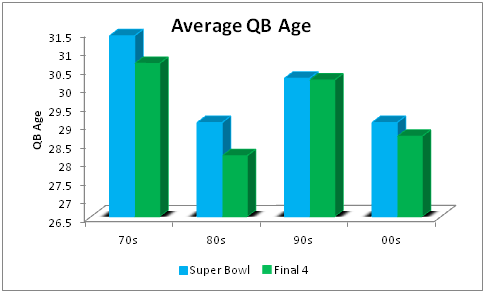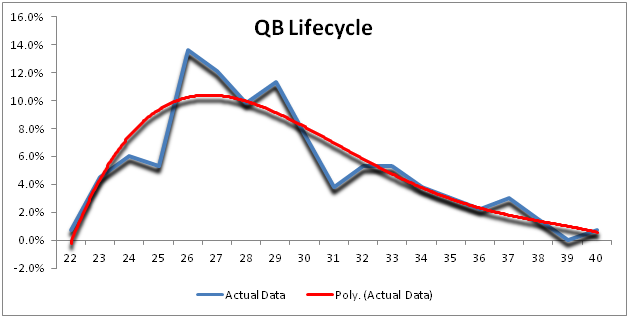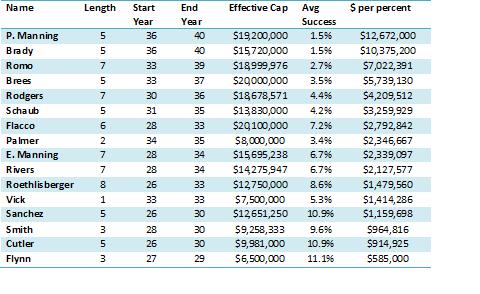[adsenseyu1]
In keeping up with our theme of extending Quarterbacks I decided to look at the age of QB’s advancing deep into the playoffs, meaning at least an appearance in a conference championship game. Why team success instead of stats? Primarily because QB’s are paid at an extremely high rate since teams are equating playoff success with QB play.
We’ll begin by breaking the numbers down by decade.

The 70’s were certainly a different brand of football. The average age of a Super Bowl participant was 31.4. The next closest decade was just 30.3. All 10 seasons in the 70’s had at least 2 QB’s over 30 and 6 years saw at least one over the age of 35. In the 33 years that have followed, only 15 seasons had at least 2 QBs over 30 leading their team to a conference championship game and only 11 seasons with a QB over the age of 35.
Focusing on 1980 thru 2012, we can begin to see some trends that develop. The following graph represents the percentage of players appearing in the championship game sorted by age, with a best fit line trend line added to smooth the data. We can call this a Quarterbacks lifecycle.

This chart really should be a guideline for teams when identifying talent and extension possibilities for the QB position. 47% of participants in the Championship game were ages 26 thru 29. It’s 54.5% if we extend it to 30. Beyond 30 the numbers begin to crumble. 18.2% were between the ages of 31 and 34 and the 35 and over category is just 10.6%. The numbers just affirm the saying that “it’s a young mans game”.
The consistent plus 31 group is from an older generation. Joe Montana and Steve Young led the way with 4 appearances while John Elway and Jim Kelly both had 3. The only players whose careers did not begin before 1990 that made the list multiple times were Tom Brady and Brett Favre, both of whom made it two times past the age of 30. The other post 90 QB’s to do it were Brad Johnson, Kurt Warner, Peyton Manning, Jake Plummer, and Donovan McNabb. Of the 7 Super Bowl winners (in which I included Phil Simms due to so many starts even though he was injured for the playoffs) only Johnson would be considered a modern era QB. Of the 14 who played in the Super Bowl a total of 4 are from the modern era (Manning, Brady, and Warner along with Johnson). That doesn’t mean nobody is going to do it again but it’s a hard task, especially if high cap charges for the aging QB, not an issue in the 80’s and even partially in the 90’s, compromise your ability to field the best roster.
As we look around the NFL there are a number of contracts that defy logic just based on the age criteria. Perhaps there is no worse contract in the NFL than the contract given to Peyton Manning. Manning fell into an age group that had a 7.6% chance of making it to at least the title game and in each season the odds get progressively worse. On average he gives the Broncos a 1.5% chance of making it and for that makes $19.2 million a season. The Broncos are paying $12.672 million per percent, by far the highest in the NFL. The Patriots, who were praised to no end (myself included) for the contract extension given to Tom Brady, have the second highest effective spend in the NFL on the position. Brady’s contract may be more difficult to escape than Manning’s, though Brady has been far more successful in the postseason and is one of the most likely candidates to make it back again to the title games as this generations Montana or Elway. Tony Romo is the 3rd worst bargain in the NFL and with no track record at all he is a prayer player for the deep playoff run.
When you look at the rookie contracts it just reinforces why teams should be considering the draft rather than overextending aging talent. Cam Newton, coming in at 22, would have about a 4.8% chance per year at making it over the terms of his rookie deal. Luck, a year older, would be at 7.7%. They both cost around $5.5 million a year, about 3.5 times less than Manning, and with a significantly higher chance at making it deep into the playoffs.
By extending a player earlier in their lifecycle a team can gain tremendous upside and flexibility. Consider the option of extending Newton when he turns 25. A 5 year extension makes Newton property of the Panthers until the age of 30. That 6 year period is the peak of the lifecycle with a 10% chance per year of making it deep into the playoffs. By extending early and rolling the 4th rookie year into the contract the effective cap values of the contract can be smoothed out and rather than just having one low cost year and a few high seasons the Panthers have the ability to have a cap affordable contract over the entire 6 year period using the extra funds to improve the quality of the team for the long term. In the event a player does not work out or you end up in cap trouble you can escape the contract with minimal cap penalties or potentially extend briefly into the low 30’s.
A perfect illustration of this is the cap killing contract of Joe Flacco versus that of Aaron Rodgers. While the two are at different stages of their careers Rodgers effective cap value is only $18.68 million a year compared to Flacco’s $20.1 million. The Ravens will be forced to extend Flacco at huge money figures when he turns 31. The effective age at which the Ravens will be able to escape Flacco is likely going to be 36 unless he fails so badly that they absorb major cap penalties when he is 32 or 33. Rodgers can be let go after the season in which he will be 34. It’s the benefit of extending early.
The worst thing a team could do is franchise their young QB. All a tag does is delay the inevitable of a long term deal. In Newton’s case you would pay a huge sum of money to invoke their 5th year option when he will be 26. Most likely you will extend the next year keeping him until he is 31 and on a contract with far less flexibility than one in which he was extended at the age of 25.
As difficult as it is for a team to let go it almost seems foolish to chase the dream with the overpriced aging QB, no matter what the track record of the player may be. Brady has probably exceeded all expectations but he is under a contract until he is 40 and in essence the deal is fully guaranteed if he remains on the team through the 2014 season. Structuring deals like the Brees contract that nearly ensures 5 years under contract is insanity. Now 34, Brees is in the age group that shows little upside, let alone at $20 million a season.
In a perfect world teams should be extending their QB’s at the ages of 25 or 26 and setting up contracts with exit strategies in the early 30s. If you must extend in the 30s the contracts need to be of the Alex Smith variety- 3 years with a rapid escape plan after 1 year. Everyone considers it a foregone conclusion that Eli Manning and Ben Roethlisberger will be extended in the next year or two. They probably will be and at least they have the pedigree to be the next group of post 30 stars, but the teams would likely be better off, if the draft quality is good, to trade such a player for multiple first round picks that can be turned into 22 or 23 year old QB’s. If a team does not have the guts to do that kind of move then the next best option is to draft QB’s in the later rounds until you find the successor. If those teams do plan on extending the earlier they do it the better off they will be when it comes to long term health. It’s far better to extend Eli at 32 than at 34 or 35 years old.
This now leads into a discussion of players currently under contract with potential extensions on the horizon, the most interesting of which looks to be Matt Ryan. I’ve said multiple times that Ryan is the best young player in the NFL, but Ryan will actually be 28 this season. This is the peak of his career and the Falcons may let him play things out. Signing him at 29 to a 5 or 6 year deal makes much less sense than locking him up at 28, though that is a better option than tagging him and then signing him at 30. Ryan probably should have been extended last season with the Falcons having plenty of options later in his career to use him to rebuild or to hope he is one of the late career success guys.
Jay Cutler will turn 30 this year, his final with the Bears. The Bears best option with him is to let him play the year out, tag him, and try to trade him to a team like the Browns or Buccaneers who will likely bid high in desperation for a QB. Phillip Rivers still has a few years remaining on his contract but with almost no dead money the next two years this is essentially a free agent year for him. He will be 32 in 2013 and the Chargers should be doing everything in their power to trade him and get younger and cheaper at the position.
The young guys are all strong candidates if the play warrants it. Matt Stafford and Josh Freeman are only 25. I don’t think either has shown enough to be extended now though Stafford’s cap numbers may force the issue. Newton, Andy Dalton and Colin Kaepernick will all be eligible after this season for extensions. Their ages will be 25, 27, and 27 respectively, making Dalton and Kaepernick both very interesting decisions if they have decent seasons. They will be at that age where waiting is counterproductive once you have made the decision that the player will be your starter for the next few years. Better to make mistakes early in the lifecycle than later in it, which should push teams to extend players like this even if some questions persist.
The following table lists the veterans in the NFL and what their effective cap charges are over the entire terms of their contracts. $/percent represents the dollar figure paid for the chance to get to the Championship round. The more expensive the worse the deal is in terms of cap management.

[adsenseyu2]


